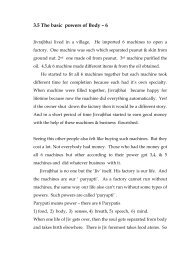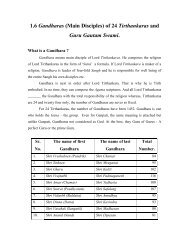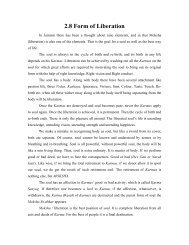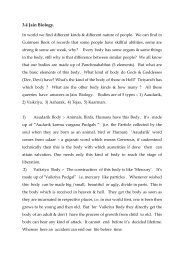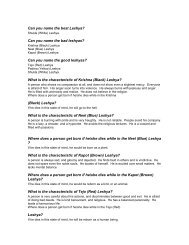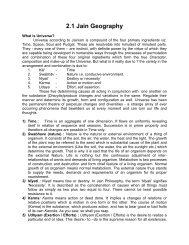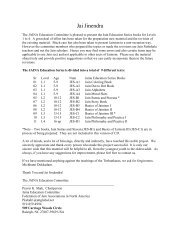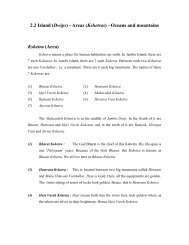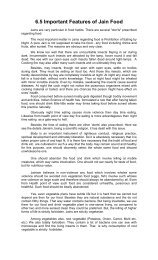In which book, Jain philosophy is - Jainism, Jain Religion - colleges
In which book, Jain philosophy is - Jainism, Jain Religion - colleges
In which book, Jain philosophy is - Jainism, Jain Religion - colleges
Create successful ePaper yourself
Turn your PDF publications into a flip-book with our unique Google optimized e-Paper software.
Question-1: <strong>In</strong> <strong>which</strong> <strong>book</strong>, <strong>Jain</strong> <strong>philosophy</strong> <strong>is</strong> described?<br />
Answer-1: There are many <strong>book</strong>s. For example, there are 45 canonical <strong>book</strong>s (<strong>Jain</strong> Ägäms)<br />
according to the Shwetambar-Murtipujak tradition. <strong>In</strong> addition there are numerous <strong>book</strong>s that<br />
provide details of <strong>Jain</strong> <strong>philosophy</strong>. If there <strong>is</strong> one <strong>book</strong> to be named for <strong>Jain</strong> <strong>philosophy</strong>, it would<br />
be “Tattvartha sutra” by Umaswati (also known as Umaswami). As a minimum, every <strong>Jain</strong> should<br />
have th<strong>is</strong> <strong>book</strong> in their home and, should read and understand it.<br />
Question-2: What <strong>is</strong> religion?<br />
Answer-2: The Sanskrit word for the religion <strong>is</strong> Dharma. Dharma means the nature of the thing.<br />
For all living beings, the soul <strong>is</strong> the real thing. The religion therefore means to see, to know and<br />
to realize the true nature of the soul. <strong>In</strong> other words, the laws of nature in truest and purest form<br />
are the religion.<br />
Laws of nature lead us to the laws of self-initiative and self-effort. Without self-efforts and selfinitiative,<br />
one cannot see, know or realize the true qualities of Self. That’s why <strong>Jain</strong><strong>is</strong>m relies a<br />
great deal on one's own efforts and initiatives, and laws of nature.<br />
Our present fate <strong>is</strong> due to our past Karma. One can change it by self-effort .<br />
Unlike other living beings, we, human beings, have reasoning mind and capacity to think<br />
rationally. We have curiosity. We want to live a peaceful, happy and simple life. Since the time<br />
immemorial, we curious human beings have been seeking answers to the questions such as: who<br />
am I? Who am I not? Who <strong>is</strong> God? Who made the universe? What <strong>is</strong> my relationship with the<br />
universe? What <strong>is</strong> my real nature? How can I achieve my own nature, my true self? How do I<br />
achieve permanent happiness? Right answers to these questions constitute the religion.<br />
Question-3: How old <strong>is</strong> the <strong>Jain</strong> religion? What <strong>is</strong> the proof of its ex<strong>is</strong>tence<br />
in the past? b) What <strong>is</strong> nature and how does it relate to <strong>Jain</strong> religion?<br />
Answer-3: It <strong>is</strong> believed that Parshvanath and Lord Mahavir were h<strong>is</strong>torical entities.The name of<br />
Rushabhdev occurs in Vedic literature. Th<strong>is</strong> makes <strong>Jain</strong><strong>is</strong>m as old as the Vedic religion, if not<br />
older. Similarly, the ex<strong>is</strong>tence of <strong>Jain</strong><strong>is</strong>m <strong>is</strong> mentioned in the canonical <strong>book</strong>s of the Buddh<strong>is</strong>m.<br />
H<strong>is</strong>torians also agree that the <strong>Jain</strong><strong>is</strong>m <strong>is</strong> a pre-h<strong>is</strong>torical religion. Recent archeological<br />
d<strong>is</strong>coveries like figures of Rushabhdev substantiate the <strong>Jain</strong> religion’s ex<strong>is</strong>tence since five<br />
thousand years. There are tens of thousands of years old caves that have paintings echoing<br />
<strong>Jain</strong><strong>is</strong>m.<br />
There has been countless time-cycles in the past. During each half time cycles (trillions and<br />
trillions of years long), we have 24 Tirthankars. Therefore, the <strong>Jain</strong> religion has been preached<br />
by our Tirthankars during each half cycle.<br />
Extraordinary details on the practice “non-violence”, the concept of six substances of the<br />
universe, nine realities and many similar things preached in <strong>Jain</strong><strong>is</strong>m do support, represent and<br />
substantiate the laws of nature and the laws of universal balance. The <strong>Jain</strong> religion and the laws<br />
of nature are synonymous. Therefore, our religion has been in ex<strong>is</strong>tence since the laws of nature<br />
have been in ex<strong>is</strong>tence. Therefore, <strong>Jain</strong>s believe that the <strong>Jain</strong> religion has been in ex<strong>is</strong>tence<br />
since the time without beginning and will have no end.
Question-4: What <strong>is</strong> the relationship between Hindu and <strong>Jain</strong> <strong>Religion</strong>s?<br />
Answer-4: Hindu and <strong>Jain</strong>, both religions are independent. It <strong>is</strong> a wrong belief that the <strong>Jain</strong><br />
religion <strong>is</strong> derived from the Vedic religion. Because of the thousands of years of common h<strong>is</strong>tory<br />
and parallel culture of Hindus and <strong>Jain</strong>s, there are many similarities. Both religions preach that<br />
non-violence constitutes the supreme religion. Hindus and <strong>Jain</strong>s are not d<strong>is</strong>tingu<strong>is</strong>hable when it<br />
comes to their attitude towards the life. It should be also noted that there are some d<strong>is</strong>tinct<br />
differences between these two religions. The concept of “non-violence” <strong>is</strong> much more detailed in<br />
<strong>Jain</strong><strong>is</strong>m. We, <strong>Jain</strong>s do not believe that the universe was created. We believe that the universe <strong>is</strong><br />
self-regulated. No one decides for us what we should get. We believe that we are the master of<br />
our own destiny. There <strong>is</strong> no divine power who decides for us. We believe all living beings are<br />
equal and all human beings are capable of achieving the liberation regardless of their race, cast,<br />
sex or color. We do not believe that the souls who have gone to Moksha come back to earth<br />
(take a rebirth) to save the world.<br />
Question-5: How does the theory of "First Chicken or Egg" fit in the <strong>Jain</strong><br />
religion?<br />
Answer-5 We do not believe in any theory like “First Chicken or Egg.” If we were created then we<br />
can be destroyed. But our soul <strong>is</strong> immortal. Therefore, we could not have been created. We<br />
<strong>Jain</strong>s believe that our souls were in ex<strong>is</strong>tence since the time without beginning and will be in<br />
ex<strong>is</strong>tence forever (has no end). There was no creation of the souls and will have no destruction<br />
of the souls. We move from one body to another until we achieve the liberation. After the<br />
liberation, we still ex<strong>is</strong>t forever in the pure soul form.<br />
Question-6: Science has proved that there <strong>is</strong> a life in the plant. Then, how<br />
can we eat vegetables and fruits?<br />
Answer-6: <strong>Jain</strong><strong>is</strong>m has said that there <strong>is</strong> a life in the plant much before the science has proved it.<br />
It <strong>is</strong> true that vegetables and fruits, both have lives. The ideal situation for a <strong>Jain</strong> would be to eat<br />
the ripe fruit that has just fallen off a tree. Vegetables and fruits are one-sensed living beings.<br />
One-sensed living beings have only “touch” sense. Their development of consciousness<br />
(knowledge) <strong>is</strong> significantly less than the higher (two, three, four and five)-sensed living beings<br />
like us, animals, birds, etc. For example, the level of knowledge of one-sensed living beings <strong>is</strong><br />
only a small fraction of one letter. It <strong>is</strong> impossible to live a life with absolute non-violence. We<br />
need to eat to survive and we need to earn to live as a “house-holder”. But the bas<strong>is</strong> of <strong>Jain</strong><strong>is</strong>m<br />
<strong>is</strong> “non-violence”. Therefore, we must minimize the act of non-violence. Eating vegetables<br />
constitutes minimum act of violence because: 1) Animals have more life-force, called Prän and<br />
more knowledge (purer -much more developed- consciousness) than the vegetables. Therefore,<br />
killing animals constitutes the higher form of violence. 2) Many other living organ<strong>is</strong>ms reside in<br />
an animal body and They get multiplied in a dead body. 3) Vegetables have less living cells and<br />
more water content. 4) We do not kill the plant for vegetables. We take leaves, vegetables and<br />
fruits off the plants. By removing vegetables and fruits from a tree, we sometimes lengthen the<br />
life span of the tree. 5) Eating vegetables <strong>is</strong> healthier. 6) The anatomy (teeth, digestive system,<br />
tongue, etc.) of human beings <strong>is</strong> for eating vegetarian food.<br />
Question-7: <strong>Jain</strong>s believe in the non-violence. Then, a) How can we take<br />
milk, butter, cheese etc.? b) What about the business of grocery,<br />
manufacturing plant etc.?
Answer-7: a) The question implies that if we cannot eat meat of cow, how can we consume<br />
cow’s milk. When we eat cow’s meat, we kill the cow. When we use cow’s milk, we do not kill<br />
the cow. But we must make sure the cow’s milk <strong>is</strong> extracted without causing pain to it and the<br />
milk was in excess (we did not deprive the cow’s off-springs). If we do not remove the excess<br />
milk from cow, we may be doing more harm to it than help. When we use the butter and cheese,<br />
we should make sure that they (specially the cheese) do not contain any animal ingredients.<br />
<strong>Jain</strong><strong>is</strong>m considers that the use of milk and milk products <strong>is</strong> not conducive to spiritual<br />
advancement. There are people in US who are called vegans. Vegans do not eat dairy products.<br />
b) We should choose a profession or a business that has minimum amount of violence. The <strong>Jain</strong><br />
Ägams recommend staying away from the trades that involve sufferings and killing of animals,<br />
affect our environment and ecology, and pollute or dry-up our natural resources. Trades that<br />
involve weapons and explosives, fire, cutting of trees, fermented products like liquor, animal parts<br />
like ivory, leather and fur; lard, meat and honey; po<strong>is</strong>onous and toxic substances, animal testing<br />
& use and prostitution need to be avoided. Moreover, we should not buy stocks or otherw<strong>is</strong>e<br />
invest in such businesses.<br />
Question-8: <strong>Jain</strong>s believe in not killing anyone. a) Suppose you are in a<br />
desert and dying of hunger and there you see a dead animal, can you eat<br />
that meat to survive? b) You go to a grocery store and are passing by meat<br />
section. You know that meat <strong>is</strong> already there. If you don’t buy it, someone<br />
else will buy and eat or it will decay. What's wrong in buying readily<br />
available meat, when you yourself haven't killed?.<br />
Answer-8: a) Dead bodies of animals contain lot of living organ<strong>is</strong>ms and that keeps on<br />
multiplying as time passes. Most organ<strong>is</strong>ms have the same color as of the meat. Therefore,<br />
eating meat of naturally dead animal does involve a high level of violence. Secondly, there <strong>is</strong> the<br />
r<strong>is</strong>k of dying by eating the dead animal because it may contain deadly decease or our digestive<br />
system may not adjust to that meat-eating. It <strong>is</strong> of course hard to court death in absence of<br />
innocent food. There are, however, examples of <strong>Jain</strong> monks who died due to severe draught<br />
rather than eating meat or even drinking sentient water. As <strong>Jain</strong>s believe that there <strong>is</strong> life after<br />
death, we should not worry about dying. One may argue that the human life <strong>is</strong> very difficult to<br />
attain. Th<strong>is</strong> <strong>is</strong> true. But the act of bad Karma (päp) like eating meat may lead to hell in the next<br />
life. Meat eating only when there <strong>is</strong> no other alternative <strong>is</strong> not acceptable to <strong>Jain</strong><strong>is</strong>m. If we<br />
practice the minor vows for house-holders, then we will not be traveling to an unknown area. We<br />
will be limiting our travels to the familiar areas. We will also be limiting our activities to the<br />
essential needs. By resorting to such precepts, one can avert such hypothetical situation.<br />
<strong>Jain</strong><strong>is</strong>m <strong>is</strong> more about prevention of wrong situations.<br />
b) Th<strong>is</strong> <strong>is</strong> fallacious since purchasing creates demand and encourages others to kill. Thus it <strong>is</strong><br />
equivalent to oneself committing the deed. The 'neat' packaging of meat hides the pain that<br />
occurred before. It <strong>is</strong> unfortunate that packaging keeps scenes of slaughterhouses off the minds<br />
of the consumers. Mahavir Bhagwan said, "It <strong>is</strong> Himsä (violence) - whether a man kills living<br />
beings himself/herself, or causes others to kill them, or gives consent to others to kill.”<br />
Question-9: I go to my friend's place, can I eat from the d<strong>is</strong>h containing<br />
meat on one side?<br />
Answer-9: The <strong>is</strong>sue <strong>is</strong> not whether you eat from the d<strong>is</strong>h containing meat on one side. The real<br />
<strong>is</strong>sue <strong>is</strong> how to avoid such a situation. You should let your friend know that you are a vegetarian<br />
and you do not eat meat. <strong>In</strong> all probabilities your friend will understand and respect your belief
and will not put you in a tough situation by serving you a d<strong>is</strong>h that contains meat. If he/she does,<br />
then he/she may not be your friend.<br />
Question-10: a) Why do I have to obey all these rules and regulations, when<br />
I don't know what will happen after the death? Why should I control myself<br />
rather than enjoy the life? b) Why can't we remember our past lives? c)<br />
What will happen if I remember the past lives?<br />
Answer-10: The phil<strong>is</strong>ophy of Chärväka did not believe in the concepts of soul and Karma. That<br />
<strong>philosophy</strong> laid down to eat, spend and materially enjoy the life even if you have to borrow. They<br />
claimed that no one knows whether there <strong>is</strong> a next life.<br />
First of all, one practices the religion to attain the long-lasting happiness. Such happiness can be<br />
achieved by removing the causes of all m<strong>is</strong>eries. Enjoying the material world may bring<br />
temporary happiness, but no one can attain the lasting happiness through material things. We<br />
know that money, power, name, etc. do not guarantee the happiness. How do we get rid of the<br />
m<strong>is</strong>eries? The root cause of all our m<strong>is</strong>eries <strong>is</strong> attachment and aversion. When we get what we<br />
want we feel happy (th<strong>is</strong> <strong>is</strong> attachment) and we become unhappy when we do not get what we<br />
want (th<strong>is</strong> <strong>is</strong> aversion). The rules and regulations are designed to reduce our attachment and<br />
aversion. However, one should not be forced to practice what <strong>is</strong> not appealing to h<strong>is</strong>/her common<br />
sense. One should adopt the minor vows according to h<strong>is</strong>/her own capacity, and then gradually<br />
progress from there.<br />
The religion <strong>is</strong> for guiding us to find the inner (permanent) happiness. The goal of the long-lasting<br />
happiness <strong>is</strong> not limited to only th<strong>is</strong> life. We believe that we had lives in past and will have lives in<br />
future until we achieve the liberation (perfect happiness). Now, the next question <strong>is</strong> - how do we<br />
know that we had previous lives and/or we will have a next life?<br />
There are four ways to decide on the things like whether there were previous lives and/or there <strong>is</strong><br />
a next life. These four ways are: 1) self-experience, 2) believe in the people who have<br />
experienced it or what <strong>is</strong> said in the <strong>Jain</strong> Ägäms (Canonical <strong>book</strong>s). 3) by inference and 4) by<br />
analogy. <strong>In</strong> th<strong>is</strong> fifth segment of the regressive half-time cycle, we do not have the people with<br />
self-experience. We have <strong>Jain</strong> Ägams that can be trusted. But in today’s world, one may ask for<br />
rationale. One has to rationalize two major aspects:: 1) belief in the ex<strong>is</strong>tence of soul and 2)<br />
belief in the theory of Karma. The ex<strong>is</strong>tence of soul can be reasoned out by comparing a dead<br />
body and a living being. The differences between these two<br />
bodies are consciousness, feeling energy, ability to act etc. These differences constitute the<br />
character<strong>is</strong>tics of the soul. Th<strong>is</strong> leads us to believe that there <strong>is</strong> a substance like soul.<br />
The theory of Karma rests on the observance of various phenomena. Why are we not equal at<br />
the time of birth? Why are some happy and some aren’t? Why are some healthy and some<br />
aren’t? Why are some good looking and some aren’t? Why are some rich and some aren’t?<br />
The rational explanation <strong>is</strong> that there has to be some aspect that makes everyone different. Per<br />
<strong>Jain</strong><strong>is</strong>m, that aspect <strong>is</strong> called “Karma”. At the time of our birth, each one of us has a different<br />
impact of Karma and that makes us different from each other. We must be carrying such Karma<br />
from the previous life. Similarly, we add or subtract to the Karma every moment. With goodpositive<br />
self-effort, we can change the impact of our Karma. As the impact decreases, the more<br />
realized are the character<strong>is</strong>tics of soul. As we know, someone gets more reward for good work in<br />
th<strong>is</strong> life, while someone gets less or no reward for the same amount of good work. Why? One<br />
kills one person and gets a death sentence. While someone else kills one hundred persons and<br />
still goes free . The reward <strong>is</strong> not equal. Therefore, there has to be a next life to take care of<br />
such d<strong>is</strong>crepancies.
The next question <strong>is</strong> - why don’t we remember our previous life? There are eight different types<br />
of Karmas. One them <strong>is</strong> knowledge-obscuring Karma. The ex<strong>is</strong>tence of that Karma does not let<br />
us completely realize the knowledge component of our consciousness (soul). There are five<br />
reasons that activate the knowledge-obscuring Karma: place, time, substance, emotions and<br />
transition to next life. We do not remember everything we know at every place, at every time.<br />
during every emotional experience and at every substance-encounter. The time, the place, the<br />
feeling and the substance involve in a particular situation decides how, when and where of its<br />
memory. The transition of our soul (with our Karman body and tejas body) to the next life<br />
activates the knowledge-obstructing Karma. Therefore, we do not remember the previous life.<br />
Since th<strong>is</strong> transition to another body <strong>is</strong> an extraordinary event as compared to other events in our<br />
life, it makes us forget about our previous life.<br />
The next question <strong>is</strong> - what happens when I remember my previous life? If th<strong>is</strong> happens, th<strong>is</strong><br />
could be the most fortunate moment of our life. We will trust every thing that <strong>is</strong> said in our<br />
Ägäms. Our life will spiritually be more focused.<br />
Question-11: I cannot live in th<strong>is</strong> modern day world without violating the<br />
five vows. What are your views?<br />
Answer-11: There are two types of vows, one for the monks and one for house-holders. The<br />
vows for monks are called the major vows (Maha Vrata). <strong>In</strong> the practice of Maha Vrata, total<br />
abstinence from violence, falsehood, stealing, carnality and possessiveness <strong>is</strong> observed. The<br />
vows for the house-holders are called minor vows (Anu Vrata). House-holders observe the vows<br />
of restraining from gross violence, lies, stealing, sexual activities and accumulation. These vows<br />
are not as strict as the major vows. Each house-holder can observe such vows according to<br />
place, time, feeling, capacity and profession. The degree of the practice can thus vary. A<br />
house-holder takes the vows with certain conditions that he/she thinks can practice without<br />
feeling m<strong>is</strong>erable. Observance of minor vows by house-holders and major vows by <strong>Jain</strong> monks<br />
has been prevalent without significant comprom<strong>is</strong>e since Bhagavän Mahavir’s time.<br />
Question-12: We say that human life <strong>is</strong> difficult to attain, but then why the<br />
population in the world <strong>is</strong> increasing? Is it because the good deeds are<br />
increasing?<br />
Answer-12: It <strong>is</strong> true that human life <strong>is</strong> difficult to attain and the world’s population <strong>is</strong> increasing.<br />
<strong>Jain</strong><strong>is</strong>m says the human life <strong>is</strong> difficult to attain in th<strong>is</strong> universe. That <strong>is</strong> said in respect to the<br />
human population in the universe. We do not have knowledge whether the population of human<br />
beings in universe <strong>is</strong> increasing or not. If it <strong>is</strong> increasing, it has an explanation that these people<br />
must have done good deeds in their past lives. The good deeds (Karma) to attain a human life<br />
include qualities like tolerance, straightforwardness, universal friendship and respecting all living<br />
beings. Therefore, the human life <strong>is</strong> difficult to attain. <strong>In</strong>tentional violence, attachment, meateating<br />
and killing of five-sensed lives lead to the life in hell. Deceit, cheating, manipulation and<br />
purposeful lying lead to a lower form of the life. Restraint, austerity, etc., lead to the life in<br />
heaven. The one sensed living beings are infinitely more than all other living beings combined.<br />
There are more two-sensed lives than three-sensed lives and onwards. The human beings are<br />
less than any other living being. <strong>In</strong> addition, the human beings are the only ones who have the<br />
capacity of rational thinking and conduct. Th<strong>is</strong> enables them to eradicate their Karmas.<br />
Therefore, the human life <strong>is</strong> the “must” before one can attain the liberation (Moksha).<br />
Question-13: Why there are 108 beads in a rosary?
Answer-13: There are five supreme entities: Arihants have 12 unique qualities, Siddhas have 8,<br />
Acharyas have 36, Upadhyayas have 25, and. Sädhus have 27. There are thus 108 unique<br />
qualities of these five supreme entities. Each bead in the rosary represents one such quality.<br />
Question-14: If Sidhdhas are also liberated souls, then what <strong>is</strong> the<br />
difference between Sidhdhas and Tirthankars?<br />
Answer-14:<br />
There are eight major types of Karmas: 1) Knowledge-Obscuring, Jnänvarniya Karma, 2)<br />
Perception-Obscuring, Darshanvarniya Karma, 3) Vigor-Obstructing, Antaray Karma, 4) Deluding,<br />
Mohniya Karma, 5) Situation-Conferrling, Vedniya Karma, 6) Body-Making, Nam Karma, 7)<br />
Status-determining, Gotra Karma and 8) Age span-Determining, Ayushya Karma.<br />
The first four are the destructive (ghäti) Karmas. They defile the real nature of the soul. The last<br />
four Karmas are non-destructive (aghäti) Karmas. When the first four Karmas are eradicated, the<br />
person becomes keveli and achieves perfect knowledge, perfect perception and perfect conduct.<br />
But there are two types of kevel<strong>is</strong>: 1. Ordinary and 2. Tirthankar. Ordinary keval<strong>is</strong> do not show<br />
the path of purification to others, while Tirthankar keval<strong>is</strong> preach the path of the purification<br />
(liberation - Moksha) to all living beings. Tirthankar means who leads us across the ocean of<br />
suffering. Tirthankar <strong>is</strong> not the founder of the religion, he/she <strong>is</strong> the propagator of truth, and path<br />
of liberation <strong>which</strong> has been preached by other Tirthankars. When a kevali, whether he/she <strong>is</strong> an<br />
ordinary or Tirthankar keveli, achieves Nirvän, he/she eradicates the remaining four (aghäti)<br />
Karmas and becomes a Sidhdha. For example, Bhagavän Mahavir became a Sidddha after h<strong>is</strong><br />
Nirvän. Since he was a Tirthankar kevali we still call him a Tirthankar.<br />
Question-15: I don't see difference between Acharya, Upadhyaya and<br />
Sädhus. They look same to me. Is that true?<br />
Answer-15: It <strong>is</strong> true that they all look same. They have chosen the same path of liberation by<br />
renouncing their worldly attachments and have taken the same great vows as required for a <strong>Jain</strong><br />
monk. However, Acharya <strong>is</strong> the head of the religious order. He <strong>is</strong> a spiritual leader and monkscholar,<br />
responsible for maintaining the rules of conduct, providing spiritual guidance and<br />
handling the organizational needs. Upädyäya <strong>is</strong> the teacher, who has a detailed knowledge of<br />
<strong>Jain</strong> canonical <strong>book</strong>s. The monks other than Ächärya and Upädyäya are the spiritual practitioner<br />
(Sädhus).<br />
Question-16: Why there are 24 Tirthankars, and not any other number?<br />
Answer-16: If we had 23 Tirthankars, then we would have a question why there are only 23, no<br />
more or no less? There are certain realities that do not need (or have) an explanation. They are<br />
just facts. So <strong>is</strong> the number of Tirthankars.<br />
Question-17: Why there <strong>is</strong> more h<strong>is</strong>tory available of Rushabhdev,<br />
Shantinath, Mallinath, Neminath, Parasnath, and Lord Mahavir Swami?<br />
Answer-17: We have more information on the lives of Rushabhdev, Shantinath, Mallinath,<br />
Neminath, Parasnath, and Mahavir Swami because there have been many extraordinary,<br />
impressive, unique and message-oriented incidents in the lives of these Tirthankars as compared<br />
to others. Rushabhdev introduced the necessary things to ease the transition from primitive life
to an organized one. For example he introduced, arts of men and women, languages, tools,<br />
business and farming, governing body to handle state affairs, etc. Also there were extraordinary<br />
events in h<strong>is</strong> and h<strong>is</strong> children’s lives. <strong>In</strong> case of Shantinäth, there was an event of the previous<br />
life of Shantinäth that he was willing to give h<strong>is</strong> own flesh to save a bird. That event emphasized<br />
the importance of non-violence. Mallinäth was a woman, and there <strong>is</strong> a event in her life that she<br />
defused the war and convinced marriage-seeking princes, who wanted to marry her, to initiate as<br />
monks. There <strong>is</strong> a very famous event in the life of Neminäth, the chapter of Nem and Rajul. Lord<br />
Mahavir had several extraordinary and exceptional events in h<strong>is</strong> life; encounter with Sangamdev,<br />
facing chandkausik, association and encounter with Goshalak, recorded d<strong>is</strong>cussion with h<strong>is</strong> tobe<br />
eleven d<strong>is</strong>ciples, case of Chandanbäla, etc. There are no significant events in the lives of<br />
other Tirthankars like these six Tirthankaras.<br />
Question-18: How do we know the future 24 Tirthankars?<br />
Answer-18: We have been told by Lord Mahavir who attained the perfect knowledge. The<br />
preaching of the Lord Mahavir was passed on to us by h<strong>is</strong> main d<strong>is</strong>ciples. The perfect knowledge<br />
means the knowledge of past, present and future about all the living beings and non-living<br />
substances..<br />
Question-19: What <strong>is</strong> the significance of Paryushana?<br />
Answer-19: Paryushana means to stay closer, to stay closer to the self - to our soul (Ätmä).<br />
Paryushana parva cons<strong>is</strong>ts of eight (Shwetambar tradition) to ten days (Digambar tradition) .<br />
During that period, <strong>Jain</strong>s practice various restraints like not eating (fasting) or eating only one<br />
meal a day and spend more time spiritually (like l<strong>is</strong>tening to <strong>Jain</strong> gurus, reading religious <strong>book</strong>s,<br />
etc.). The last day of thie period <strong>is</strong> called Samvatsari (annual ceremony of atonement), when<br />
people undertake atonement of wrong activities during the previous 12 months. They admit their<br />
sins and pray for forgiveness (ksama). Adm<strong>is</strong>sion of sins and praying for forgiveness are directed<br />
towards the spiritual teachers, family members, friends and others regardless of age or sex.<br />
Letters are written to the people they know and who were not approachable in person on the<br />
Samvatsari day acknowledging the wrong doings and seeking the forgiveness. The aspirant on<br />
h<strong>is</strong> part gives forgiveness to all living beings and asks for the same favor from others. Th<strong>is</strong> <strong>is</strong><br />
usually done through the Samvatsari Pratikraman (Pratikraman means to return from sins or<br />
faults) and ra<strong>is</strong>es the real spirit of universal friendship and goodwill: (Khämemi savvajive savve<br />
Jiva khamantu me ! Mitti me savvabhuesu veram majjha na kenai (It means - I forgive to all<br />
living beings; may all of them forgive me. I have a friendship with all living beings and hostility<br />
towards none). The pratyäkhyäna (renunciation of certain things) aspect <strong>is</strong> very elaborate during<br />
the Paryushana parva. The Samvatsari Pratikraman <strong>is</strong> considered a highly important practice<br />
during the Paryushana parva, <strong>which</strong> <strong>is</strong> the most important <strong>Jain</strong> festival.<br />
Question-20: Why do I have to pray everyday? Why do we worship<br />
Tirthankar's idol? Why do I have to worship Idol with sandal wood paste,<br />
flowers etc.? Why people take fruits, sweets etc. to the temple?<br />
Answer-21: We pray/worship to pay our respects to the Tirthankars because they have attained<br />
liberation and have laid down the path of liberation. We want to get inspiration to become like<br />
them. By praying them, we receive the spiritual incentive to follow the right path of purification.<br />
We do not pray/worship for any favors or material benefits from the Tirthankars or from monks<br />
and nuns.
There are eight things involved in worshipping (puja) the Tirthankaras: 1. Jal Puja: (Water) 2.<br />
Chandan Puja: (Sandal-wood) 3. Pushpa Puja: (Flower) 4. Dhup Puja: (<strong>In</strong>cense) 5. Dipak Puja:<br />
(Candle) 6. Akshat Puja: (Rice) 7. Naivedya Puja: (Sweet food) 8. Fal Puja: (Fruit).<br />
Symbolically each item represents a specific religious virtue <strong>which</strong> one should reflect<br />
(contemplate) in h<strong>is</strong>/her mind while performing puja.<br />
Question-21: Why do we need a worshipping place? Can't we do same<br />
thing in our own home?<br />
Answer-21: The worshipping place provides the necessary environment for spiritual up-liftment<br />
just as the school provides for education. One who <strong>is</strong> spiritually advanced, can continue the<br />
spiritual activity at any place. But for most of the Sansär<strong>is</strong> (house-holders) we need to depend<br />
upon outside sources such as temple to make initial progress in the spiritual direction. It <strong>is</strong> also<br />
acceptable that one can practice h<strong>is</strong>/her religion from home as long as he/she achieves the<br />
similar or better results. For most people, the combination of both <strong>is</strong> recommended.<br />
Question-22: Define the dreams according to <strong>Jain</strong> religion?<br />
Answer-22: According to <strong>Jain</strong><strong>is</strong>m the dreams are not only thoughts, images and emotions during<br />
the sleep; the dreams could be indicative of our past experiences as well as what will happen in<br />
future. Per <strong>Jain</strong><strong>is</strong>m, we get dreams due to: 1) experiences in th<strong>is</strong> life, 2) what we heard, 3)<br />
experiences of our previous life, 4) gas, cough or acidity problems, 5) own-nature of our soul, 6)<br />
worries, 7) contact with heavenly beings, 8) religious experiences or acts, and 9) activation of<br />
good or bad Karma. First six types of dreams may not be fruitful, but the last three dreams can<br />
be fruitful. Per <strong>Jain</strong><strong>is</strong>m, we should not go back to sleep if we see the best dream.<br />
Question-23: What <strong>is</strong> the significance of the 14 dreams, <strong>which</strong> mother<br />
Tr<strong>is</strong>hala had? and why no less or more?<br />
Answer-23: There <strong>is</strong> a <strong>book</strong> on dreams in <strong>Jain</strong><strong>is</strong>m that explains significance of dreams, types of<br />
dreams and results of dreams. <strong>In</strong> that <strong>book</strong>, it <strong>is</strong> stated that all Tirthankars’ mothers get the same<br />
14 dreams at the time of conception. .<br />
Queen Tr<strong>is</strong>hala, the mother of Lord Mahavir at midnight saw fourteen beautiful and wholesome<br />
dreams after conception. They were: 1. Elephant 2. Bull 3. Lion 4. Goddess Laxmi 5. Garland<br />
of Flowers 6. Full Moon 7. Sun 8. Large Flag 9. Silver Urn 10. Lotus-Lake 11. Milky-Sea 12.<br />
Celestial Air-plane 13. Heap of Gems 14. Smokeless Fire.<br />
1. Elephant: She saw a big, tall, and impetuous elephant. It had two pairs of tusks. The color of<br />
the elephant was white and its whiteness was superior to the color of marble. Th<strong>is</strong> dream<br />
indicates that her son will guide the spiritual chariot, and save human beings from m<strong>is</strong>ery, greed,<br />
and attraction of life.<br />
2. Bull: The color of the bull was also white, but it was brighter than white lotuses. It glowed with<br />
beauty and radiated light all around. It was noble, grand, and had a majestic hump. It had fine,<br />
bright, and soft hair on its body. Its horns were superb and sharply-pointed. Th<strong>is</strong> dream<br />
indicates that her son will be a spiritual teacher of great ascetics, kings, and other great<br />
personalities.<br />
3. Lion: Its claws were beautiful and well-po<strong>is</strong>ed. The lion had a large well-rounded head and<br />
extremely sharp teeth. Its lips were perfect, its color was red, and its eyes were sharp and<br />
glowing. Its tail was impressively long and well-shaped. Queen Tr<strong>is</strong>hala saw th<strong>is</strong> lion
descending towards her and entering her mouth. Th<strong>is</strong> dream indicates that her son will be as<br />
powerful and strong as a lion. He will be fearless, mighty, and capable of ruling over the world.<br />
4. Goddess Laxmi: The fourth dream Queen Tr<strong>is</strong>hala saw was of the Goddess Laxmi, the<br />
Goddess of wealth, prosperity and power. She was seated at the top of mountain Himalaya. Her<br />
feet had a sheen of golden turtle. She had a delicate and soft fingers. Her black hairs were tiny,<br />
soft, and delicate. She wore rows of pearls interlaced with emeralds and a garland of gold. A<br />
pair of earring hung over her shoulders with dazzling beauty. She held a pair of bright lotuses.<br />
Th<strong>is</strong> dream indicates that her son will attain great wealth, power, prosperity.<br />
5. Garland of Flowers: The fifth dream Queen Tr<strong>is</strong>hala saw was of a celestial garland of flowers<br />
descending from the sky. It smelled of mixed fragrances of different flowers. The whole universe<br />
was filled with fragrance. The flowers were white and woven into the garland. They bloomed<br />
during all different seasons. A swarm of bees flocked to it and they made a humming sound<br />
around the region. Th<strong>is</strong> dream indicates that the fragrance of her son's preaching will spread<br />
over the entire universe.<br />
6. Full Moon: The sixth dream queen Tr<strong>is</strong>hala saw was of a full moon. It presented an<br />
auspicious sight. The moon was at its full glory. It awoke the lilies to bloom fully. It was bright<br />
like a well pol<strong>is</strong>hed mirror. The moon radiated whiteness like a swan. It inspired the oceans to<br />
surge skyward. The beautiful moon looked like a radiant beauty-mark in the sky. Th<strong>is</strong> dream<br />
indicates that her son will have a great physical structure, and be pleasing to all living beings of<br />
the universe.<br />
7. Sun: The seventh dream Queen Tr<strong>is</strong>hala saw was of a huge d<strong>is</strong>c of sun. The sun was<br />
shining, and destroying darkness. It was red like the flame of the forest. Lotuses bloomed at its<br />
touch. The sun <strong>is</strong> the lamp of the sky and the lord of planets. The sun rose and and put to end<br />
the evil activities of the creatures who thrive at night. Th<strong>is</strong> dream indicates that the teaching of<br />
her son will destroy anger, greed, ego, lust, pride, etc. from the life of the people.<br />
8. Large Flag: The eighth dream Queen Tr<strong>is</strong>hala saw was of a very large flag flutterling from a<br />
golden staff. The flag fluttered softly in the gentle breeze. It attracted the eyes of all. Peacock<br />
feathers decorated its crown. A radiant white lion was on it. Th<strong>is</strong> dream indicates that her son<br />
will be great, noble, and well respected leader of the family.<br />
9. Silver Urn: The ninth dream Queen Tr<strong>is</strong>hala saw was of a silver urn (Kälsh) full of crystal-clear<br />
water. It was a magnificent, beautiful, and bright pot. It shone like gold and was a joy to behold.<br />
It was garlanded with strings of lotuses and other flowers. The pot was holy and untouched by<br />
anything sinful. Th<strong>is</strong> dream indicates that her son will be perfect in all virtues.<br />
10. Lotus-Lake: The tenth dream Queen Tr<strong>is</strong>hala saw was of a lotus lake (padma-sagar).<br />
Thousands of lotuses were floating on the lake <strong>which</strong> opened at the touch of the sun's rays. The<br />
lotuses imparted a sweet fragrance. There were swarms of f<strong>is</strong>h in the lake. Its water glowed like<br />
flames of fire. The lily-leaves were floating on the water. Th<strong>is</strong> dream indicates that her son will<br />
help to liberate the human beings who are tangled in the cycle of birth, death, and m<strong>is</strong>ery.<br />
11. Milky-sea: The eleventh dream Queen Tr<strong>is</strong>hala saw was of a milky sea. Its water swelled out<br />
in all directions, r<strong>is</strong>ing to great heights with turbulent motions. Winds blew and created waves. A<br />
great commotion was created in the sea by huge sea animals. Great rivers fell into the sea,<br />
producing huge whirlpools. Th<strong>is</strong> dream indicates that her son will navigate through the ocean of<br />
birth, death, and m<strong>is</strong>ery leading to Moksha or liberation.<br />
12. Celestial air-plane: The twelfth dream Queen Tr<strong>is</strong>hala saw was of a celestial airplane. The<br />
airplane had eight thousands magnificent gold pillars studded with gems. The plane was framed<br />
with sheets of gold and garlands of pearls. It was decorated with rows of murals depicting bulls,<br />
horses, men, crocodiles, birds, children, deers, elephants, wild animals, and lotus flowers. The
plane resounded with celestial music. It was saturated with an intoxicating aroma of incense<br />
fumes. It was illuminated with a bright silvery light. Th<strong>is</strong> dream indicates that all gods and<br />
goddesses in heaven will respect and salute h<strong>is</strong> spiritual teaching and will obey him.<br />
13. Heap of Gems: The thirteenth dream Queen Tr<strong>is</strong>hala saw was of a great heap of gems, as<br />
high as Mount Meru. There were gems and precious stones of all types and kinds. These gems<br />
were heaped over the earth and they illuminated the entire sky. Th<strong>is</strong> dream indicates that her<br />
son will have infinite virtues and w<strong>is</strong>dom.<br />
14. Smokeless Fire: The fourteenth dream queen Tr<strong>is</strong>hala saw was of a smokeless fire. The fire<br />
burned with great intensity and emitted a radiant glow. Great quantities of pure ghee was being<br />
poured on the fire. It burned with numerous flames. Th<strong>is</strong> dream indicates that the w<strong>is</strong>dom of her<br />
son will excel the w<strong>is</strong>dom of all other great people.<br />
Question-24: When and under what circumstances different branches of<br />
<strong>Jain</strong> religion started? What are the different sects in <strong>Jain</strong><strong>is</strong>m? Why they<br />
can't Unite?<br />
Answer-24: About 170 years after Mahavir's Nirvän, Acharya Bhadrabahu Swami became the<br />
head of the <strong>Jain</strong> order. That time. Chandra Gupta Maurya was the king in Magadha. During that<br />
time a famine occurred for twelve years. (Th<strong>is</strong> <strong>is</strong> a h<strong>is</strong>torical fact). Acharya Bhadrabhahu had<br />
predicted that long famine and realized that it will be very difficult for monks to strictly follow<br />
religion (Five Mahavrats, no clothes, beg food in hands, etc.). Therefore he, along with twelve<br />
thousands of h<strong>is</strong> d<strong>is</strong>ciples, migrated to south and settled there so that they can follow the strict<br />
religious rules. The remaining monks were led by Acharya Sthulibhadra and he relaxed some of<br />
the rules for the monks for survival during th<strong>is</strong> famine. That was the primary cause of the<br />
separation of Digambar and Shwetambar sects. However, the real separation occurred during<br />
the time of Acharya Vajrasen (six hundred years after Mahavir's Nirvän). It <strong>is</strong> a fact that Mahavir<br />
did not wear clothes after renunciation. However, h<strong>is</strong> d<strong>is</strong>ciples were of both types (clad as well<br />
as unclad). The d<strong>is</strong>ciples of Parshwanath (23rd Tirthankar) wore white clothes.<br />
Shwetambar <strong>Jain</strong>s are also divided into two major subsects: Shwetambar Murti Pujak (Idol<br />
worshiper) and Shwetambar Sthanakwasi (Non-idol worshiper). There <strong>is</strong> an offshoot among<br />
Sthanakwas<strong>is</strong> <strong>which</strong> <strong>is</strong> known as Terapanthi. Digambar <strong>Jain</strong>s are divided into three major<br />
subsects: B<strong>is</strong>a Panth that accepts Bhattarak's authority, Terah Panth <strong>which</strong> does not accept such<br />
authority, and Taran Panth- Non-Murti pujak sect .<br />
The essential <strong>philosophy</strong> of all <strong>Jain</strong> sects <strong>is</strong> similar. The similarities ex<strong>is</strong>t in many areas: 1.<br />
Concept of God 2. Every soul has the potential for becoming God or Siddha. 3. Metaphysics, 4.<br />
The universe composed of six substances, 5. Philosophy of Karma, 6. The seven/nine<br />
fundamentals (tattvas) 7. Right perception (Samyag Darshan), Right Knowledge (Samyag Jnan)<br />
and Right Conduct (Samyak Charitra) as the path of liberation. 10. five vows, 11.Five<br />
meticulosities (Samities), 12 Control over mental, verbal and physical activities (Three Gupties),<br />
13 Multiplicity of view points (Anekantwad/Syadwad), 14) Five types of Knowledge (Jnan), 15<br />
Fourteen Stages of elevation (Gunasthanak), 16 Twelve reflections (Bhavanas), 17 Four types of<br />
Meditations (Dhyan), 18 Six types of Leshyas (psychic coloration), 19 Emergence of 12<br />
Tirthankars in each half time cycle, 20 Namaskar Maha Mantra and 21 Authority of Tattvartha<br />
Sutra are recognized by all the <strong>Jain</strong> sects.<br />
The following, however, are the major differences. 1 Agams: Digambar <strong>Jain</strong>s believe that all the<br />
original Ägams (Äng and Purva Ägams) have been lost. Most of them might have been lost<br />
during the twelve years of famine that occurred during the time of the Chandra Gupta Maurya<br />
(300 B.C.). They recognize other <strong>book</strong>s written by great Acharyas like Kundkunacharya.<br />
Shwetambar <strong>Jain</strong>s believe that 600 years after Lord Mahavir's Nirvan all Purva Ägams were lost
or not remembered by monks and hence were not saved. Only Ang and Non-Ang Ägams could<br />
be preserved. 2 Life after kevaljnan: Digambars believe that after attaining Kevaljnan,<br />
Tirthankars and other Kevaljnan<strong>is</strong> do not eat or drink; while Shwetambars believe that they<br />
continue to eat and drink like other human beings and continue to lead the renunciate life for the<br />
remaining period of their life. 3 Sex of Tirthankars: Digambars believe that all the Tirthankars are<br />
necessarily male and there <strong>is</strong> no exception. Shwetambars believe that generally they are male<br />
but in the present series of 24 Tirthankars, the nineteenth Tirthankar, Mallinath was a female and<br />
that was an exception to the rule. 4 Sex of other Keval<strong>is</strong>: Digambars believe that only males can<br />
attain liberation. A female has to be reborn as a male in order to attain liberation. Shwetambars<br />
believe that both males and females can attain liberation. 5. Clothes and Food: Digambar monks<br />
do not wear any clothes. They beg for food in their hands and eat only once a day. Shwetambar<br />
monks and nuns wear white clothes and they beg food in pots generally once a day. They bring<br />
the food to Upashraya or other place of their residence and ask their Guru for perm<strong>is</strong>sion to eat<br />
their meal. They do not eat food in the presence of laymen. 6. Mahavir's conception:<br />
Shwetambars believe that Mahavir's fetus was transferred from mother Devananda (Bhraman<br />
family) to mother Tr<strong>is</strong>hala (Kshatriya family), while Digambars believe that he was conceived by<br />
mother Tr<strong>is</strong>hala and the question of fetus transfer does not ar<strong>is</strong>e. 7 Marital status of Mahavir:<br />
Digambars believe that Mahavir was not married, while Shwetambars believe that Mahavir was<br />
married with Yashoda and they had a daughter named Priyadarshan. 8. Tirthankara's Murti<br />
(Idol): The Tirthankar's idol can have ornaments and decorations, and their eyes look toward the<br />
worshiper in Shwetambar Murti Pujak sect. Digambar idols do not have ornaments and their<br />
eyes are turned downward in meditating position. 9. Pratikraman, Samayik, and Puja rituals are<br />
different.<br />
It can be seen that all <strong>Jain</strong> sects have remarkable similarity in their <strong>philosophy</strong> despite minor<br />
areas of d<strong>is</strong>agreements. Recently, there have been several collaborative works by all major<br />
sects. <strong>Jain</strong>s from different sects outside <strong>In</strong>dia seem to have more unity and harmony..<br />
About Nonviolence (Ahimsä)<br />
Ahimsä and Anekäntväd (non-violence and multiplicity of views) are the bases of <strong>Jain</strong><strong>is</strong>m. All<br />
other aspects are the branches of these two aspects. The fundamentals of non-violence are: 1)<br />
all living beings are equal, 2) every living being wants to live and does not want to die, 3) every<br />
living being wants to be happy and does not like pain and 4) we need to treat others the way we<br />
like to be treated.<br />
Question-25: What do we mean by Himsä - violence?<br />
Answer-25: The nature of non-violence <strong>is</strong> judged by our intentions and actions. If a person<br />
deliberately and knowingly harms other living beings, it <strong>is</strong> violence. But if involuntarily or in<br />
unavoidable circumstances, some insects are killed, then it <strong>is</strong> an exceptional situation. Whether it<br />
<strong>is</strong> by our actions, or by our speech or by our thoughts, hurting others <strong>is</strong> Himsä - violence.<br />
Question-26: What <strong>is</strong> so unique about the non-violence preached by<br />
<strong>Jain</strong><strong>is</strong>m?<br />
Answer-26: <strong>In</strong> <strong>Jain</strong><strong>is</strong>m, non-violence <strong>is</strong> a timeless and far-reaching concept that can be applied<br />
to every aspect of life. <strong>Jain</strong> <strong>philosophy</strong> provides enough inforMation regarding non-violence.<br />
Non-violence does not mean merely avoiding physical violence, but it also means minimizing the<br />
violence of thought and speech. <strong>Jain</strong><strong>is</strong>m states that anger, pride, greed, deceit, jealousy, etc.
constitute mental violence. Harsh language, unnecessary talk, lying, ins<strong>is</strong>ting on own ideas and<br />
not l<strong>is</strong>tening to others constitute the verbal violence.<br />
Question-27: What do we mean by minimizing necessary violence?<br />
Answer-27: <strong>Jain</strong>s are real<strong>is</strong>tic; They recognize that absolute non-violence <strong>is</strong> not practical by a<br />
lay-person. For example, we have to cook, eat, earn, wear and travel. These activities involve<br />
certain amount of unintentional but necessary violence. However, while undertaking such<br />
necessary activities, we must minimize the violence. For example: do not waste water and eat<br />
vegetables rather than eating meat.<br />
Question-28: But we are told that vegetables and animals both have lives.<br />
Then how can eating vegetables be less violent than eating meat?<br />
Answer-28: The ideal situation for a <strong>Jain</strong> would be to eat the ripe fruit that has just fallen off a<br />
tree. However that <strong>is</strong> hardly practicable. It <strong>is</strong> true that vegetable plants and animals both have<br />
lives. But eating vegetable <strong>is</strong> less violent, because: 1) We do not kill the plant for vegetables.<br />
We take leaves, vegetables and fruits off the plants. By removing vegetables and fruits from a<br />
tree, we sometimes lengthen the life span of the tree. 2) Animals have more life-force, called<br />
prän and more and higher consciousness than the vegetables. Therefore, killing animals<br />
constitutes the higher level of violence. 3) Many other living organ<strong>is</strong>ms reside in an animal body<br />
and they get multiplied in a dead body. 4) Vegetables have less living cells and more water<br />
content.<br />
Question-29: But meat-eating makes people stronger and healthy. Is it true?<br />
Answer-29: No. It <strong>is</strong> a wrong belief that animal food makes us stronger and healthy. The human<br />
physiology <strong>is</strong> for eating and digesting vegetarian food and <strong>is</strong> significantly different from meateating<br />
animals. Animal food <strong>is</strong> laced with fat, cholesterol, pesticides, hormones, antibiotics and<br />
similar harmful ingredients. Meat eaters are more prone to heart failure, cancer and other killer<br />
d<strong>is</strong>eases. Animal food transmits as many as 160 contagious d<strong>is</strong>eases to humans under natural<br />
conditions. Animal food also lowers the immune status. Vegetarian<strong>is</strong>m increases endurance and<br />
stamina, and makes people healthy and smart. Vegetarian food prevents various cancers,<br />
hemorrhoids, constipation, ulcer and many d<strong>is</strong>eases. Smart animals like elephants, cows, bulls,<br />
gorillas, horses, apes and chimpanzees are all vegetarian.<br />
Question-30: But Non-vegetarians argue that the meat <strong>is</strong> the best source of<br />
protein. Is it true?<br />
Answer-30: No, it <strong>is</strong> not true. Meat provides much more protein than the daily need of an<br />
average person, <strong>which</strong> <strong>is</strong> 10 to 15 grams. Excessive intake of protein <strong>is</strong> harmful. <strong>In</strong> addition, the<br />
meat protein <strong>is</strong> d<strong>is</strong>ease-prone. Protein from vegetarian foods (specially from beans) <strong>is</strong> very<br />
useful and quality-prone while it <strong>is</strong> not excessive. Similarly, vegetarians get their calcium, iron<br />
and other vitamin needs from various vegetables, dark and leafy greens, beans, cereals, nuts,<br />
fruits, juices, milk, yogurt etc. Do you know that 120 million animals a week are killed for food in<br />
the United States. Th<strong>is</strong> <strong>is</strong> equivalent of one animal per person per year on the earth.<br />
Question-31: Will my being vegetarian stop violence to animals?
Answer-31: Not totally, but it will definitely decrease violence to animals. Being vegetarian <strong>is</strong> a<br />
right step in the direction of achieving the goal. <strong>In</strong> the beginning only one person takes the<br />
initiative for every cause, others follow him. Our example will encourage others. Some will<br />
renounce animal food, and so it will go on multiplying.<br />
Question-32: Should we react to an attack in self-defense? Should we get<br />
rid of violent animals?<br />
Answer-32: Well, these are two questions. For lay-persons, to defend against an attack <strong>is</strong><br />
justifiable. <strong>In</strong> self-defense, even the killing of a man <strong>is</strong> considered justifiable, because the<br />
motivation <strong>is</strong> preservation of life. Self defense cannot be considered destruction of life. We have<br />
examples in <strong>Jain</strong> Ägams having people gone to heaven while fighting against attack. But to kill<br />
dangerous animals like snakes, lions, wolves and tigers <strong>is</strong> wrong, unless they happen to attack<br />
you. 'Live and let live' <strong>is</strong> the best <strong>philosophy</strong> to follow. <strong>Jain</strong> monks are, however, not supposed to<br />
react even to the violent attack.<br />
Question-33: Some people may say: What <strong>is</strong> wrong in being a nonvegetarian<br />
if someone else does the killing?<br />
Answer-33: Th<strong>is</strong> <strong>is</strong> fallacious since purchasing creates demand and encourages others to kill.<br />
It <strong>is</strong> therefore equivalent to committing the deed. The 'neat' packaging of meat conceals the pain<br />
that occurred before. It <strong>is</strong> unfortunate that packaging keeps scenes of slaughterhouses off the<br />
minds of the consumers. Mahavir Bhagwan said, "It <strong>is</strong> Himsä (violence) - whether a man kills<br />
living beings himself/herself, or causes others to kill them, or gives consent to others to kill.”<br />
Question-34: Why meat-eating Europeans and Americans are more civilized,<br />
learned and powerful?<br />
Answer-34: Their civilization, learning or power <strong>is</strong> not due to meat-eating. It <strong>is</strong> due to other fine<br />
qualities like d<strong>is</strong>cipline, hard work, self-effort, higher productivity and quality, open-mindedness,<br />
adventurous nature, innovation, honesty, generosity, compassion, and natural resources. They<br />
also realize that vegetarian<strong>is</strong>m <strong>is</strong> good for health. There are already more than 10 million<br />
Americans who are vegetarian. Do you know that Albert Einstein, Isäc Newton, George Bernard<br />
Shaw, Leo Tolstoy and Socrates were vegetarian, not to mention Michael Jackson, Madonna and<br />
ex-Beatle Paul McCartney.<br />
Question-35: How does the vegetarian<strong>is</strong>m help ecology and environment?<br />
Answer-35: Vegetarian<strong>is</strong>m promotes animal preservation and forestry, and thus ecology and<br />
environment. Let me explain you by giving few stat<strong>is</strong>tics: 1) one acre of trees <strong>is</strong> spared each year<br />
by every individual who switches to vegetarian diet, 2) it takes 55 square foot of rain-forest to<br />
produce one pound of hamburger 3) it requires 2500 gallons of water to produce one pound of<br />
meat (one pound of wheat requires only 50 to 75 gallons of water), 4) 85% of annual US top soil<br />
<strong>is</strong> lost due to ra<strong>is</strong>ing livestock. Do you know that one pound of beef requires 16 pound of grains<br />
and soybeans. Do you know that 15 vegetarians can be fed if one person gives up eating meat.<br />
Question-36: Is there any violence involved in using cosmetics?<br />
Answer-36: Cosmetics look innocent but there <strong>is</strong> a lot of hidden violence. Cosmetics use many<br />
animal ingredients such as carminic acid, elastin, sperm oil and musk oil. To produce one pound<br />
of carminic acid, 70,000 insects are crushed. Another ingredient called “elastin” <strong>is</strong> obtained from
neck lingaments and aorta of cattle. Sperm oil <strong>is</strong> the oil extracted from intelligent mammal,<br />
whale. Musk oil <strong>is</strong> extracted from musk of deers, beavers, civet cats and other genitals.<br />
Make sure cosmetics, soaps, detergents, shampoos, skin creams, oven cleaners, shaving<br />
creams, etc. have alternative synthetics and plant t<strong>is</strong>sues, no animal ingredients. or have<br />
“Cruelty Free” logo on these products. Read the labels and avoid the products with ingredients<br />
like glycerides, gelatin, lecithin, stearates, enzymes, lard and tallow. Do you know that an<br />
estimated 14 million animals die every year because of animal testing for cosmetics.<br />
Question-37: What’s wrong in wearing silk sarees or silk clothes?<br />
Answer-37: Some think that they look cool when they wear silk. Some <strong>Jain</strong>s wear silk when they<br />
go to deräsar for pooja. Do you know that the silk <strong>is</strong> made out of silkworms. To produce 100<br />
grams of pure silk, 1500 silkworms (chrysal<strong>is</strong>) have to be killed. It <strong>is</strong> unnecessary to wear silk<br />
when we have other alternatives. If you want to look cool, wear artificial silk.<br />
Question-38: How about the use of leather?<br />
Answer-38: We wear leather belts, leather shoes. We use leather brief cases, we use leather<br />
purses. We have leather interior in our cars. We have leather furniture. Some people wear<br />
leather belt or carry leather purse when they go to temples. Leather <strong>is</strong> nothing but the skin of<br />
killed animal. Do we need to make a fashion statement by using leather when other alternatives<br />
are available?<br />
Question-39: Every one knows what’s wrong with the use of alcohol, but<br />
what’s wrong about honey?<br />
Answer-39: It <strong>is</strong> okay to have our parents call each other honey or if they call us honey. But it <strong>is</strong><br />
Himsä to eat honey. Let me explain you how honey <strong>is</strong> made. Honeybees painstakingly take the<br />
nectar out of flowers and put in their pouches (sacs). While extracting the nectar, they also pick<br />
up many small insects. Then, the honeybees comeback to their nest and vomits the nectar in the<br />
honeycombs. Honeycomb <strong>is</strong> a mass of hexagonal wax cells built by honeybees in their nest to<br />
contain their eggs, offspring and for storing the honey. Thus, honey contains many small insects,<br />
eggs of bees and d<strong>is</strong>abled bees. Like alcohol, there are millions of single-sense organ<strong>is</strong>ms,<br />
called nigoda, in honey. Therefore, we should avoid eating honey. It <strong>is</strong> said that we commit sin<br />
equivalent to burning seven villages by eating one drop of honey.<br />
Question-40: What kind of professions should we stay away?<br />
Answer-40: We should choose a profession or business that involves minimum violence. <strong>Jain</strong><br />
Ägams recommend staying away from the trades that involve sufferings and killing of animals,<br />
affect our environment and ecology, and pollute or dry-up the natural resources. Trades that<br />
involve weapons and explosives, fire, cutting of trees, fermented products like liquor, animal parts<br />
like ivory, leather and fur; lard, meat and honey; po<strong>is</strong>onous and toxic substances, anmal testing &<br />
use and prostitution are required to be avoided. We should not even buy stocks or invest in such<br />
businesses.<br />
Question-41: Did we m<strong>is</strong>s any significant <strong>is</strong>sues of physical violence?<br />
Answer-41: Yes, Animal testing in medical field and use of animals in entertainment. Animal<br />
testing in medical fields can be minimized. Most of the medical testing does not require animals.
Consuming a medicine that was tested on animal <strong>is</strong> a sinful act. Consult your doctor if there <strong>is</strong> an<br />
alternative medicine that was not tested on animal. We should also avoid the entertainment<br />
programs that involve use of animals.<br />
Question-42: What do we mean by violence of speech and thoughts?<br />
Answer-42: We <strong>Jain</strong>s are very careful about physical Himsä but we often commit verbal and<br />
mental violence, because we do not fully understand the violence by speech and thoughts.<br />
Without proper knowledge, we are like a blind person who <strong>is</strong> surrounded by a fire. Let me give a<br />
few examples of what constitutes verbal or mental violence. Presumptions, suspicion, anger,<br />
ego, deceit, greed, spiritual-laziness, lying, spreading rumors, character assassination, wilful<br />
m<strong>is</strong>guidance, forgery, use of harsh language, giving wrong suggestions, hidden agenda,<br />
d<strong>is</strong>closing one’s secrets, manipulation, desire for power, superiority complex, d<strong>is</strong>honesty, causing<br />
fear to others, personal jokes, laughing at someone’s failures or m<strong>is</strong>eries and similar activities<br />
constitute violence of thoughts and speech.<br />
Question-43: How do we stop violence of speech and thoughts?<br />
Answer-43: Do you know that Hitler was a vegetarian? It means that being a vegetarian <strong>is</strong> not<br />
good enough. To be a truly non-violent person, we must develop the virtues of forgiveness,<br />
tolerance, humility, straightforwardness and contentment. We must adopt Anekäntväd<br />
(multiplicity of views) in thinking and Syädväd (theory of “from certain point of view”) in speaking.<br />
Without that, we will never be really non-violent. Also we need to practice the four bhävanas of<br />
Maitri, Pramod, Karuna and Mädhyastha.




